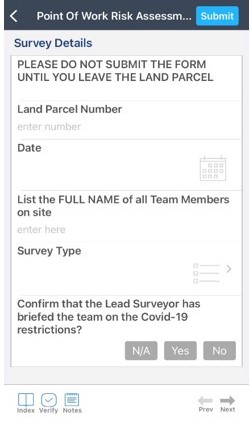Improving dynamic risk assessments through digital application
Dynamic Risk Assessments (DRA) undertaken on site have traditionally used paper forms. Paper forms can be difficult to complete or become damaged in poor weather conditions, get mislaid and often result in time lags in wider information sharing. The High Speed Two (HS2) Phase 2a team created a digital version of the DRA form. Using a digital application, Fastfield, the DRA form improved the accuracy of data capture and timescales for notifications/information sharing. The digital application is an easy to use form that is hosted on the surveyor’s mobile or iPad.
Using a digital DRA form has resulted in cost savings of almost £100k, reduced risk of recording incorrect information due to data transfer errors and faster notification of DRAs and information available to other teams planning work at or near the same location.
This paper will be of interest to other projects considering digitisation of their on-site risk assessment activities.
Background and industry content
Dynamic risk assessments have traditionally used paper-based forms to capture and report site observations. However delays in reporting of site observations led the Health and Safety Team on the Phase 2a project of High Speed Two (HS2) to investigate and consider how to improve communications from site.
The paper system was found not to be robust and site attendees were struggling to send in the forms at the end of day due to data service issues from being in rural areas. Photographs required separate submissions, and that delayed and complicated the process further. Furthermore the paper forms were difficult to interpret once received due to some being weathered from the outdoor conditions and being illegible. This added to delays in identifying crucial site observations or hazards and often led to numerous phone calls with the site attendees. Once all information and photos were received and clarified with the site attendees, all needed to be manually processed and filed. This led to further delays. The whole process was prone to human error.
The team decided to investigate a digital solution.
Developing a digital application
After various conversations with internal teams and optioneering, a paid digital application known as ‘Fastfield’[1]was identified as a possible solution. This software, available on Apple App store and Google Apps, allows users to create their own forms in order to be used on site and sent back in real time. The forms could be submitted when the user was offline and so data service was not going to cause an issue with using this software.
As this application charges a small fee per user per month, a business case was created, and a briefing was held with the client in order to discuss the possibility of the use of the application for the project and funding. After various discussions the application and funding were approved and the app was launched.

Lessons learned and successes
The major success of using Fastfield has been allowing the rapid response from site to be received along with the ability to take photos and provide clear locations of where site observations and hazards were located was an excellent help to inform subsequent visits. All surveyors attending site now use this application and site teams are able to send back survey completion details in real time.
This application also assisted the Health and Safety Team with incident investigations. The application was easy to configure and develop digital forms using inbuilt form builder. It could capture data remotely and without the need for an internet connection.
Another real benefit was the ability to capture photos, signatures, and GPS locations. The application could also integrate with third party applications (SharePoint, Power BI). The application could be downloaded onto a mobile device or tablet device from Apple and Google App Store.
As the need to have a coordinator to process the paper forms manually was removed, productivity in other areas of work improved. As part of the business case created for Fastfield the cost saving to the project with using the application was a total of £97,962.50.
Recommendations
A key recommendation would be to have a dedicated and experienced IT resource at the start to set up the form and train a member of the project team on how to create forms, use the data and manage the form, as edits will always need to be made to the form once it is launched and feedback from site is provided.
A test run is always important from site personnel also, to ensure they are happy with the form and the questions being asked. Set up instructions will need to be shared with the site attendees to ensure a smooth transition from paper forms to digital form.
It is also useful to hold a general induction to the tool with the teams – this enables users to ask questions, provide suggestions and be involved with the process from the start.
A move to a digital platform can sometimes be alarming to some, so it is important to do it slowly and have multiple conversations around the change.
Acknowledgements
The Health and Safety Team would like to acknowledge the Arup IT team along with the critical support from members of the internal project management team Tim Williams (Arup) and Richard Livingstone Jones (Arup) who assisted with developing a business case and approving this application for use on the project.


